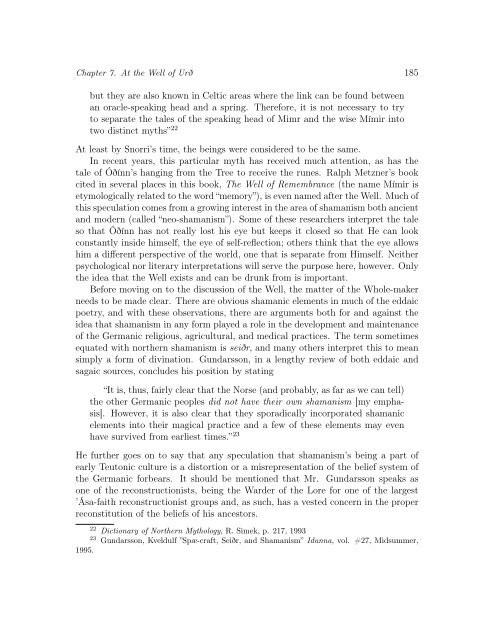Untitled - Awaken Video
Untitled - Awaken Video
Untitled - Awaken Video
You also want an ePaper? Increase the reach of your titles
YUMPU automatically turns print PDFs into web optimized ePapers that Google loves.
Chapter 7. At the Well of Urð 185<br />
but they are also known in Celtic areas where the link can be found between<br />
an oracle-speaking head and a spring. Therefore, it is not necessary to try<br />
to separate the tales of the speaking head of Mimr and the wise Mímir into<br />
two distinct myths” 22<br />
At least by Snorri’s time, the beings were considered to be the same.<br />
In recent years, this particular myth has received much attention, as has the<br />
tale of Óðínn’s hanging from the Tree to receive the runes. Ralph Metzner’s book<br />
cited in several places in this book, The Well of Remembrance (the name Mímir is<br />
etymologically related to the word “memory”), is even named after the Well. Much of<br />
this speculation comes from a growing interest in the area of shamanism both ancient<br />
and modern (called “neo-shamanism”). Some of these researchers interpret the tale<br />
so that Óðínn has not really lost his eye but keeps it closed so that He can look<br />
constantly inside himself, the eye of self-reflection; others think that the eye allows<br />
him a different perspective of the world, one that is separate from Himself. Neither<br />
psychological nor literary interpretations will serve the purpose here, however. Only<br />
the idea that the Well exists and can be drunk from is important.<br />
Before moving on to the discussion of the Well, the matter of the Whole-maker<br />
needs to be made clear. There are obvious shamanic elements in much of the eddaic<br />
poetry, and with these observations, there are arguments both for and against the<br />
idea that shamanism in any form played a role in the development and maintenance<br />
of the Germanic religious, agricultural, and medical practices. The term sometimes<br />
equated with northern shamanism is seiðr, and many others interpret this to mean<br />
simply a form of divination. Gundarsson, in a lengthy review of both eddaic and<br />
sagaic sources, concludes his position by stating<br />
“It is, thus, fairly clear that the Norse (and probably, as far as we can tell)<br />
the other Germanic peoples did not have their own shamanism [my emphasis].<br />
However, it is also clear that they sporadically incorporated shamanic<br />
elements into their magical practice and a few of these elements may even<br />
have survived from earliest times.” 23<br />
He further goes on to say that any speculation that shamanism’s being a part of<br />
early Teutonic culture is a distortion or a misrepresentation of the belief system of<br />
the Germanic forbears. It should be mentioned that Mr. Gundarsson speaks as<br />
one of the reconstructionists, being the Warder of the Lore for one of the largest<br />
’Ása-faith reconstructionist groups and, as such, has a vested concern in the proper<br />
reconstitution of the beliefs of his ancestors.<br />
1995.<br />
22 Dictionary of Northern Mythology, R. Simek, p. 217, 1993<br />
23 Gundarsson, Kveldulf ”Spæ-craft, Seiðr, and Shamanism” Idunna, vol. #27, Midsummer,
















